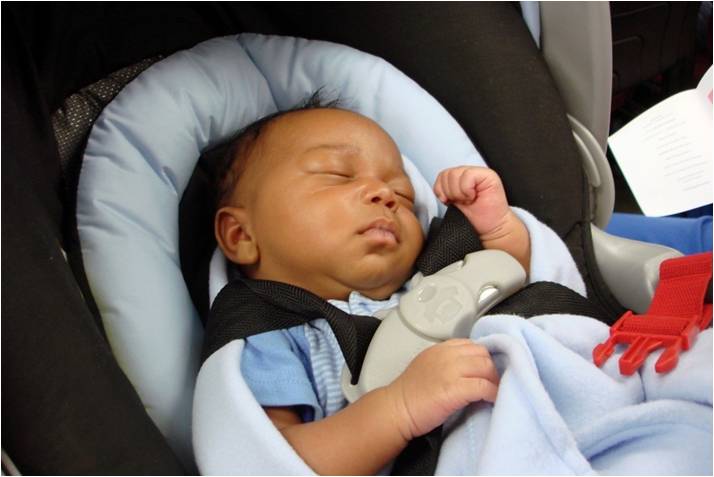A 2016 study found that babies 4 weeks and under are at greater risk of positional asphyxia. Older babies and toddlers also face the risk of positional asphyxia, especially after spending over an hour in a car seat.
Children will have trouble breathing while sitting in their car seats for over an hour. This is why doctors urge parents to limit any drives over 30 minutes.
What Is Positional Asphyxia?
According to the NIH, positional asphyxia is a rare cause of sudden infant death syndrome and a difficult diagnosis. It occurs when someone’s position prevents them from breathing properly. This condition is based mostly on the circumstances of the incident; along with particular external and internal findings, frequent in asphyxia (signs of sudden death).
Babies who experience positional asphyxia cannot breathe because the position of their body blocks their airway. This can occur in several ways:
- When the mouth and nose are blocked by something covering them.
- When the passage of air from mouth and nose to lungs is blocked because a baby’s head is slumped over; or a baby’s chin is pressing into the baby’s chest.
This condition can happen to anyone; but it’s most common in infants when a baby cannot get enough oxygen to breathe. And this is due to the positioning of their body. Some believe this type of asphyxiation is a result of an infant being trapped between a surface; with their nose and/or mouth covered and restricting air. And while this absolutely is the cause for some positional asphyxia infant deaths, it’s certainly not the cause for all of them.
Who Is At Risk Of Positional Asphyxia?
The list of people who are at risk of positional asphyxia includes:
- newborn babies
- infants
- older babies
- toddlers
- adults
Infants under four months old do not have proper head and neck control. And they are unable to move their heads when their airways become compromised. And the frightening fact is that their little airways can become inhibited just by the tilt of their head (for example: when their chin is against their chest). So being in a car seat for long periods of time is extremely risky for these babies.
But even if you have older babies who can stay in a car seat longer, it’s important not to let them continue sleeping in it once you get home. A separate study from the Children’s Hospital Medical Center in Ohio found that the leading cause of death during a baby’s first year is sleep-related; and incorrect use of car seats plays into this.
“Car seats should not be used as sleeping areas outside of the vehicle, and children should never be in a car seat with unbuckled or partially buckled straps,” the researchers stated. That’s because babies can slouch down and the restraints can actually cut off oxygen; without the parents’ knowledge that they’re suffering from asphyxiation.
Reduced oxygen levels can lead to later cognitive or behavioural problems. Also, babies die quickly when they cannot breathe – it takes just a few minutes.
How Is It A Cause Of Death?
Older infants and toddlers have also died from positional asphyxia. This has happened when people place car seats on beds and other furniture and roll over and trap the infant or toddler. Infants and toddlers left to sleep in a car seat have also died when they slump and rest their chin on their chest, restricting or stopping breathing. Those who are awake but are left unattended in a car seat or sling die because their movements may block their nose and mouth, preventing breathing.
What Are The Preventive Measures Available To Parents?
Parents should:
- Sleep in the same room with the baby until they are a year old.
- Use sleepers instead of blankets.
- Put baby to sleep on a flat surface.
- Throw out or return recalled baby items.
- Keep baby away from second and third-hand smoke.
- Put baby to sleep on their back.
- Create a safe space without pillows or blankets if deciding to co-sleep or bed-share.
- Refrain from using drugs and alcohol.
- Vaccinate.
- Don’t leave baby in a car seat or baby rocker for more than an hour
- Once baby falls asleep in car seat or rocker, bring them out
Safety Precautions with Car seats
Make sure that everyone using the car seat practices how to install the seat and harness the baby with a child passenger safety technician. The state or county health department can be called for assistance.
- Loose straps or harness can trap infant’s head or neck; follow manufacturer’s instructions to ensure that the straps are properly adjusted.
- Car seats should only be used in a car or other vehicle.
- Infants in a car seat should be able to be observed by a responsible adult.
- Whenever possible, an adult should ride in the back seat with baby to check baby’s head and neck position and breathing.
- Use only straps to position baby correctly and do not add pillows or blankets.
- Always make sure straps are completely buckled.
- Make sure baby’s chin is up at all times.
This article was first published on AfricaParent.com
Copyright 2025 TheCable. All rights reserved. This material, and other digital content on this website, may not be reproduced, published, broadcast, rewritten or redistributed in whole or in part without prior express written permission from TheCable.
Follow us on twitter @Thecablestyle

